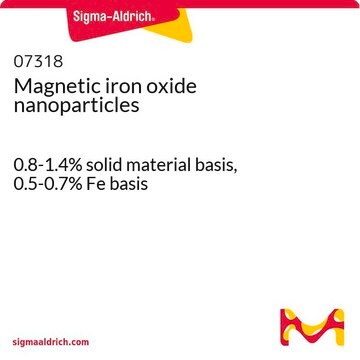TEM used to check particle size. Light Scattering or similar methods are not utilized.
Wichtige Dokumente
700320
Eisenoxid(II,III), magnetische Nanopartikel -Lösung
5 nm avg. part. size, 5 mg/mL in toluene
Synonym(e):
Magnetische Eisenoxid Nanokristalle, Magnetit, Superparamagnetische Eisenoxid Nanopartikel
Größe auswählen
About This Item
Empfohlene Produkte
Form
nanoparticles
solution
Qualitätsniveau
Konzentration
5 mg/mL in toluene
Magnetisierung
≥30 emu/g (at ambient temperature under 4500 Oe)
Durchschnittliche Teilgröße
5 nm
Partikelgröße
5 nm±1 nm (TEM; conforms)
Dichte
0.865 g/mL at 25 °C
SMILES String
O=[Fe].O=[Fe]O[Fe]=O
InChI
1S/3Fe.4O
InChIKey
SZVJSHCCFOBDDC-UHFFFAOYSA-N
Suchen Sie nach ähnlichen Produkten? Aufrufen Leitfaden zum Produktvergleich
Verwandte Kategorien
Allgemeine Beschreibung
Signalwort
Danger
Gefahreneinstufungen
Aquatic Chronic 3 - Asp. Tox. 1 - Flam. Liq. 2 - Repr. 2 - Skin Irrit. 2 - STOT RE 2 - STOT SE 3
Zielorgane
Central nervous system
Lagerklassenschlüssel
3 - Flammable liquids
WGK
WGK 3
Flammpunkt (°F)
39.9 °F
Flammpunkt (°C)
4.4 °C
Persönliche Schutzausrüstung
Eyeshields, Faceshields, Gloves, type ABEK (EN14387) respirator filter
Zulassungslistungen
Zulassungslistungen werden hauptsächlich für chemische Produkte erstellt. Für nicht-chemische Produkte können hier nur begrenzte Angaben gemacht werden. Kein Eintrag bedeutet, dass keine der Komponenten gelistet ist. Es liegt in der Verantwortung des Benutzers, die sichere und legale Verwendung des Produkts zu gewährleisten.
EU REACH Annex XVII (Restriction List)
Hier finden Sie alle aktuellen Versionen:
Besitzen Sie dieses Produkt bereits?
In der Dokumentenbibliothek finden Sie die Dokumentation zu den Produkten, die Sie kürzlich erworben haben.
Kunden haben sich ebenfalls angesehen
Artikel
Graphene is a unique two-dimensional (2D) structure of monolayer carbon atoms packed into a dense honeycomb crystal that has attracted great interest due to its diverse and fascinating properties.
Professor Hui Mao explores the use of superparamagnetic iron oxide nanoparticles (INOPs) that offer an alternate contrast-enhancing mechanism.
Prof. Yadong Yin discusses various synthesis methods of magnetite nanocrystals and their applications in different fields.
Magnetic materials find diverse applications from data storage to renewable energy.
-
What method is used to determine the size of the particles in Product 700320, Iron oxide, magnetic?
1 Antwort-
Hilfreich?
-
-
What is the coating thickness of oleic acid on product number 700312, 700320, and 700304, Iron oxide(II,III), magnetic nanoparticles solution?
1 Antwort-
The suppliers of the magnetic iron oxide nanoparticles in toluene have indicated that the particles are essentially coated with a monolayer of oleic acid. Since the oleic acid is a long chain hydrocarbon there can exist some folding and irregular structure on the surface. The suppliers estimate that one should add 1-2 nm to the particle size due to the presence of the oleic acid coating. From this, 1.5 nm is the closest approximation of coating thickness as provided by our suppliers.
Hilfreich?
-
-
How is the magnetization of Product 700320, Iron oxide, magnetic, determined?
1 Antwort-
Per the supplier, the magnetization is determined by using a Magnetic Susceptibility Balance.
Hilfreich?
-
-
How should a sample of the Iron oxide(II,III), magnetic nanoparticles solution in toluene be prepared for analysis by transmission electron microscopy (TEM)?
1 Antwort-
The particle size is determined by TEM.If the solution as provided is not diluted, a superlattice of multilayer nanocrystals will form on the grid, appearing to be an aggregate. The solution can be diluted with the same solvent that it was shipped in (toluene). A solution diluted to 0.1-0.5 mg/mL should be concentrated enough to get a nice picture. One drop per grid should be sufficient. (Since the solution is provided at a concentration of 5 mg/mL, this would be a 10- to 50-fold dilution.)After applying the sample to the grid, a drying time of a minimum of 10-15 minutes is recommended.After performing several successful dilutions and getting good results, the analyst will get a feel for the correct dilution just by judging the color and darkness of the diluted sample. If you see lone isolated dots in the TEM, then your sample is too dilute. If you cannot distinguish separate particles, it is too concentrated. Good record keeping will help to zero in on the best dilution factor for the type of picture that you want.
Hilfreich?
-
-
What is the Department of Transportation shipping information for this product?
1 Antwort-
Transportation information can be found in Section 14 of the product's (M)SDS.To access the shipping information for this material, use the link on the product detail page for the product.
Hilfreich?
-
-
What is the purpose of the oleic acid in Product 700320, Iron oxide, magnetic?
1 Antwort-
Per the manufacturer, the oleic acid allows the iron oxide nanoparticles to be soluble in the solvent (i.e. toluene).
Hilfreich?
-
Aktive Filter
Unser Team von Wissenschaftlern verfügt über Erfahrung in allen Forschungsbereichen einschließlich Life Science, Materialwissenschaften, chemischer Synthese, Chromatographie, Analytik und vielen mehr..
Setzen Sie sich mit dem technischen Dienst in Verbindung.



